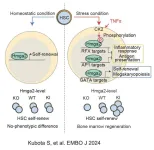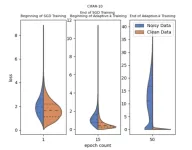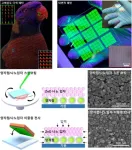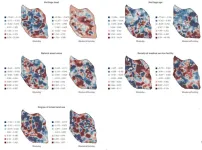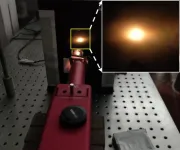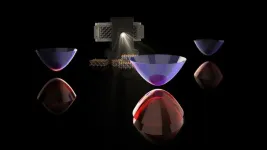(Press-News.org) My new article, ‘Quantum Entanglement of Optical Photons: The First Experiment, 1964-67’, is intended to convey the spirit of a small research project that reaches into uncharted territory. The article breaks with tradition, as it offers a first-person account of the strategy and challenges for the experiment, as well as an interpretation of the final result and its significance. In this guest editorial, I will introduce the subject and also attempt to illuminate the question ‘What is a paradox?’
Let’s begin with the gyroscope that I bought when I was eight, from a store that sold novelties and magic tricks. The spinning disk, supported at one end of its shaft, did not fall, but moved slowly around in a horizontal plane. This behavior seems mysterious or paradoxical in the context of common experience that excludes gyroscopes, but makes complete sense in the context of Newtonian mechanics, which resolves the paradox by predicting precisely how gyroscopes will behave.
Quantum theory, conceived in the mid-1920s, has been impressively successful in accounting for the properties and interactions of atoms and molecules. In 1935, Einstein, Podolsky, and Rosen stirred controversy with a thought experiment in which two particles of common origin move apart, noting that quantum theory predicts correlations in subsequent measurements of their spins. The correlation may seem quite puzzling, as a measurement on one of the particles appears to influence a subsequent measurement on the other, even if the particles do not interact. In current terminology, these correlations are an example of entanglement, and the correlation phenomenon is known as the EPR paradox. The puzzle has become a subject for much discussion and analysis, especially because there was (and is) no known mechanism for measurements to communicate with each other.
Disentangling entanglement
In 1964 I was intrigued by this unfamiliar effect and began to think of a way to actually perform the EPR experiment – or at least a version of it – for observing the correlation and entanglement. It would be a low-energy experiment that could be set up in a small laboratory.
For the experiment outlined here, the particles of interest are visible-light photons, which are noninteracting, emitted by excited calcium atoms in a two-stage spontaneous emission process. The polarization states of the photons, which are related to their spins, can be measured simply, with ordinary linear polarizers. Photomultiplier detectors count the individual photons, #1 (green) and #2 (violet), and timing circuits enable the identification of photon pairs from the same atom. A rotatable linear polarizer is mounted in front of each detector.
In simplest terms, the experiment involves counting the rate at which photon pairs are detected, as a function of the orientation of the polarizers. A photon pair detected from the same atom is recorded as a “coincidence count.”
Quantum theory makes the following predictions:
Each photon, taken separately, has a 50% chance of being transmitted by its polarizer, regardless of its angle of orientation.
If the polarizer axes are parallel, both photons from the same atom can pass through their polarizers and be counted. Coincidence counts will be observed.
If the polarizer axes are perpendicular, it never happens that both photons pass through their polarizers. Therefore, no coincidence counts will be observed.
Predictions #1 and #2 are not surprising, as the green and violet beams of light are unpolarized.
Prediction #3, discussed further in my article, is a quantum entanglement effect with no analog in classical (non-quantum) physics. It is especially interesting because it can be tested experimentally. I designed the experiment specifically for this purpose.
The results of the experiment, after nearly three years of effort in the laboratory, clearly demonstrate that coincidence counts are recorded if the polarizer axes are parallel, and that no coincidences are recorded if the polarizers are perpendicular. The agreement between theory and experiment is unequivocal and striking.
So is there a paradox?
In our brief discussion of the gyroscope, no paradox was acknowledged because Newton’s theory (classical dynamics) fully explains how a gyroscope moves. Furthermore, both the theory and the observed gyroscopic behavior are compatible with our life experience and intuitive ability to grasp natural processes in the classical realm.
In the entanglement case, quantum theory accounts for the observed correlation of the photon polarizations. But even when a theory predicts experimental results, a paradox may remain if the intuition cannot reach out to connect with it.
Take another look at predictions #1 and #3 above. If we draw on our experience of life in a non-quantum world, we may notice something very strange when the polarizers are “crossed” at 90 degrees. If each photon has a 50% chance of transmission through its polarizer, why don’t we get coincidences 25% of the time? Instead, we observe none at all. At first consideration, this does seem to qualify as a paradox. One possible explanation could involve a missing component of quantum theory – perhaps a causal mechanism that could allow one photon, or one measurement, to communicate with the other. However, despite extensive research, no evidence has been found for such a mechanism.
As we do not live in an overtly quantum world, classical phenomena may influence our thought processes – even when we venture into the quantum realm. It may therefore remain a challenge to assimilate entanglement into the intuition. I believe that the paradox can be at least partially resolved when further thought and experience, such as the experiment considered here, ‘stretch the mind’ to more fully embrace entanglement and other quantum phenomena.
I have come to view these aspects of nature as ‘strangely wonderful’.
END
Prof Carl Kocher explores how you can stretch your mind to grasp quantum entanglement
2024-08-22
ELSE PRESS RELEASES FROM THIS DATE:
Unveiling the secret of blood regeneration: New insights into stress responses in hematopoietic stem cells (HSC)
2024-08-22
Kumamoto University researchers have made a groundbreaking discovery that sheds light on how the HMGA2 gene—an essential transcriptional activator involved in chromatin modification—regulates stress responses in hematopoietic stem cells (HSCs), thereby enhancing blood cell production recovery.
Exposure to infections or treatments such as chemotherapy often leads to a rapid decline in blood cells, including red blood cells and platelets. HSCs, which reside in the bone marrow that can develop into various types of blood cells, are crucial for recovering from these stress-induced blood disorders. Under stressd ...
MCG physicians working to help prevent vision loss associated with space travel
2024-08-22
Physicians at the Medical College of Georgia at Augusta University are working with Polaris Dawn, the first of the Polaris Program’s three human spaceflight missions, to better understand the eye changes many astronauts experience during spaceflight that can leave them with a wide range of symptoms once they return to Earth — from a new need for glasses to significant loss of vision. The Polaris Program is a first-of-its-kind effort to rapidly advance human spaceflight capabilities while continuing to raise funds and awareness for important causes on Earth.
More than 70% of astronauts experience a phenomenon ...
Adaptive-k: A simple and effective method for robust training in label noisy datasets
2024-08-22
Training deep learning models on large datasets is essential for their success; however, these datasets often contain label noise, which can significantly decrease the classification performance on test datasets. To address this issue, a research team consisting of Enes Dedeoglu, H. Toprak Kesgin, and Prof. Dr. M. Fatih Amasyali from Yildiz Technical University developed a groundbreaking method called Adaptive-k, which improves the optimization process and yields better results in the presence of label noise. Their research was published on 15 August 2024 in ...
Developing innovative new display technologies! Create ultrahigh-definition screens efficiently!
2024-08-22
□ A team led by Professor Ji-woong Yang of DGIST’s (President Kun-woo Lee) Department of Energy Science and Engineering, in collaboration with Professor Moon-kee Choi of UNIST's Department of New Materials and Dr. Taeg-hwan Hyun of the IBS Nanoparticle Research Center, has developed a double-layer dry transfer printing technology that simultaneously transfers light-emitting and electron-transferring layers onto a substrate. This technology is expected to provide a more life-like view in augmented reality (AR) and virtual reality (VR), greatly enhancing the immersive experience.
□ ...
Physicist Hollen honored as Moore Foundation Experimental Physics Investigator
2024-08-22
Shawna Hollen, associate professor of physics, has been named to The Gordon and Betty Moore Foundation’s 2024 cohort of Experimental Physics Investigators. The prestigious honor, which is accompanied by $1.25 million in funding over the next five years, will advance understanding of the link between charge density waves and quantum dots, two physical phenomena that could lead to improvements in quantum computing.
“The ideas that I put forward [in my proposal] haven’t been demonstrated. It’s not something that anyone else ...
How do the characteristics of historic urban landscapes influence public sentiments, and what implications do these findings have for urban planning and development strategies?
2024-08-22
In 2011, UNESCO issued The UNESCO Recommendation on the Historic Urban Landscape (“The Recommendation” hereafter), introducing the concept of “historic urban landscape” (HUL). HUL is defined as “the urban context and its geographical setting taking into consideration the historical layering of cultural and natural values and attributes”. It is noteworthy that ancient towns or historic cities, as an important subclass of HUL, have garnered increasing attention. In recent years, public perception and emotional experience of physical environments have become ...
Low-cost flexible metasurfaces to increase the efficiency of optoelectronic devices
2024-08-22
Metasurfaces are two-dimensional counterparts of metamaterials, which are the artificial materials that possess unusual characteristics. With a variety of fascinatingly innovative and diverse uses, these specially-prepared surfaces with engineered patterns can modify the propagation of electromagnetic waves across the entire spectrum of wavelengths. Though the journey of metamaterials began with metal-dielectric systems, the metasurfaces have gone all-dielectric, and are crucial in applications relating to optoelectronic devices such as solar cells and light emitting diodes (LED) to improve their efficiency through a mere surface effect.
Student researchers led ...
When climate reporting fails to create impact
2024-08-22
This year, New Zealand became among the first countries in the world to force their largest companies and financial institutions (about 200 in all) to disclose their climate-related risks and opportunities in their annual reports, and make regulatory filings.
Over the last month, these reports have been filed under the disclosure regime led by the Financial Markets Authority.
But do these kinds of initiatives improve environmental outcomes?
A new study, co-authored by Professor Charl de Villiers (University of Auckland, Business ...
Researchers observe floquet states in colloidal nanoplatelets driven by visible pulses
2024-08-22
Solution-processed semiconductor nanocrystals are also called colloidal quantum dots (QDs). While the concept of size-dependent quantum effects had been long known to physicists, a sculpture of the theory into real nanodimensional objects remained impossible till the discovery of QDs. The size-dependent colors of QDs are essentially naked-eye, ambient-condition visualization of the quantum size effect. In recent years, researchers across the world have been searching for fascinating quantum effects or phenomena using the material platform of QDs, such as single-photon emission and quantum coherence manipulation.
Floquet states (i.e., ...
Antarctica vulnerable to invasive species hitching rides on plastic and organic debris
2024-08-22
Antarctica’s unique ecosystems could be threatened by the arrival of non-native marine species and marine pollution from Southern Hemisphere landmasses, new oceanographic modelling shows.
In a study published today in Global Change Biology, scientists from UNSW Sydney, ANU, University of Otago and the University of South Florida suggest that floating objects can reach Antarctic waters from more sources than previously thought.
“An increasing abundance of plastics and other human made debris in the oceans means there are potentially more opportunities ...
